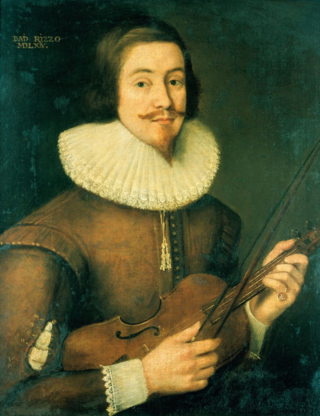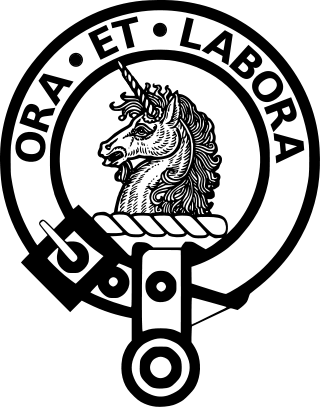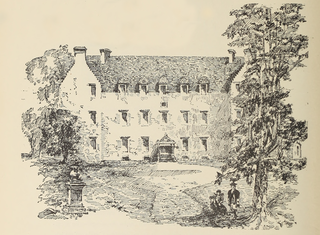
David Rizzio or Riccio was an Italian courtier, born in Pancalieri close to Turin, a descendant of an ancient and noble family still living in Piedmont, the Riccio Counts di San Paolo e Solbrito, who rose to become the private secretary of Mary, Queen of Scots. Mary's husband, Lord Darnley, is said to have been jealous of their friendship because of rumours that Rizzio had impregnated Mary, and he joined in a conspiracy of Protestant nobles to murder him, led by Patrick Ruthven, 3rd Lord Ruthven. Mary was having dinner with Rizzio and a few ladies-in-waiting when Darnley joined them, accused his wife of adultery and then had a group murder Rizzio, who was hiding behind Mary. Mary was held at gunpoint and Rizzio was stabbed numerous times. His body took 57 dagger wounds. The murder was the catalyst of the downfall of Darnley, and had serious consequences for Mary's subsequent reign.

Peeblesshire, the County of Peebles or Tweeddale is a historic county of Scotland. Its county town is Peebles, and it borders Midlothian to the north, Selkirkshire to the east, Dumfriesshire to the south, and Lanarkshire to the west.
William Maxwell, 5th Earl of Nithsdale, was a Roman Catholic member of the Scottish nobility who took part in the Jacobite rising of 1715. He was attainted with his titles forfeited. However, Lord Nithsdale made a celebrated escape from the Tower of London by changing clothes with his wife's maid the day before he was due to be executed. The lordship of Herries of Terregles was later restored to his descendants and remains extant.

Clan Ramsay is a Lowland Scottish clan.

Dunrobin Castle is a stately home in Sutherland, in the Highland area of Scotland, as well as the family seat of the Earl of Sutherland and the Clan Sutherland. It is located one mile north of Golspie and approximately five miles south of Brora, overlooking the Dornoch Firth.

Clan Murray is a Highland Scottish clan. The chief of the Clan Murray holds the title of Duke of Atholl. Their ancestors were the Morays of Bothwell who established the family in Scotland in the 12th century. In the 16th century, descendants of the Morays of Bothwell, the Murrays of Tullibardine, secured the chiefship of the clan and were created Earls of Tullibardine in 1606. The first Earl of Tullibardine married the heiress to the Stewart earldom of Atholl and Atholl therefore became a Murray earldom in 1626. The Murray Earl of Atholl was created Marquess of Atholl in 1676 and in 1703 it became a dukedom. The marquess of Tullibardine title has continued as a subsidiary title, being bestowed on elder sons of the chief until they succeed him as Duke of Atholl.
James Stewart, 1st Earl of Buchan (1442–1499) was a Scottish noble. He was the uncle of James III of Scotland who granted him the Earldom of Buchan. Buchan repaid his nephew by fighting for his cause against rebellious southern barons. Through his marriage to Margaret Ogilvy he acquired the title Lord Auchterhouse.

Callendar House is a mansion set within the grounds of Callendar Park in Falkirk, central Scotland. During the 19th century, it was redesigned and extended in the style of a French Renaissance château fused with elements of Scottish baronial architecture. However, the core of the building is a 14th-century tower house.

Clan Moncreiffe is a Highland Scottish clan.

Clan Irvine is a Scottish clan.

Terregles House was a late 18th-century country house, located near Terregles, in the historical county of Kirkcudbrightshire around 2 miles west of Dumfries in Scotland. It replaced an earlier tower house, which had served as the seat of the Lords Herries, and later the Earls of Nithsdale, until William Maxwell, the 5th Earl, forfeited his titles in 1716.
The Much Honoured is an honorific style applied to the holders of certain Scottish feudal baronies, lairds, and chiefs and chieftains.

Traquair is a small village and civil parish in the Scottish Borders; until 1975 it was in the county of Peeblesshire. The village is situated on the B709 road 2.0 miles (3.2 km) south of Innerleithen at grid reference NT330346.

The Douglases of Mains are a branch of the Clan Douglas, related to the Lords of Douglas through Archibald I, Lord of Douglas. The first Laird obtained land through marriage into the Galbraith family, which had been granted land in New Kilpatrick by Maldowen, Earl of Lennox. The family produced minor nobles in the Scottish court, perhaps the most notable of which was Malcolm Douglas, the 8th Laird, executed for treason in Edinburgh for conspiracy in the Raid of Ruthven. His second son, Robert Douglas, was made Viscount of Belhaven and is buried in Holyrood Abbey. The family intermarried in the Glasgow area, having links with the Campbells of Blythswood, with landed families across Scotland and more latterly the United Kingdom. The title became extinct in the 20th century; the last 33+1⁄2 acres of the estate was sold to Dunbartonshire county and was subsequently used for the erection of the secondary school, Douglas Academy, in Milngavie prior to the death of the last heir in 1977.
David Paton was a Scottish artist active between 1660–1700.

Sir Hugh Paterson, 1st Baronet of Bannockburn, was a Scottish baronet and landowner.
William Stewart of Monkton and Carstairs was a Scottish landowner and courtier.
Catherine Margaret Mary Maxwell Stuart, 21st Lady of Traquair is a Scottish landowner, politician, hotelier, brewer, and writer. She is the first female Laird of Traquair and, at the time she succeeded her father in 1990, she was the only female laird in Scotland. She took over the management of the lairdship from her mother in 1999, which includes a bed and breakfast and ancient brewery. A lifelong socialist, Maxwell Stuart ran for public office four times as a Labour Party candidate, including in the 2003 Scottish Parliament election and the 2007 Scottish Parliament election.

John Stewart of Traquair was a Scottish landowner.

















